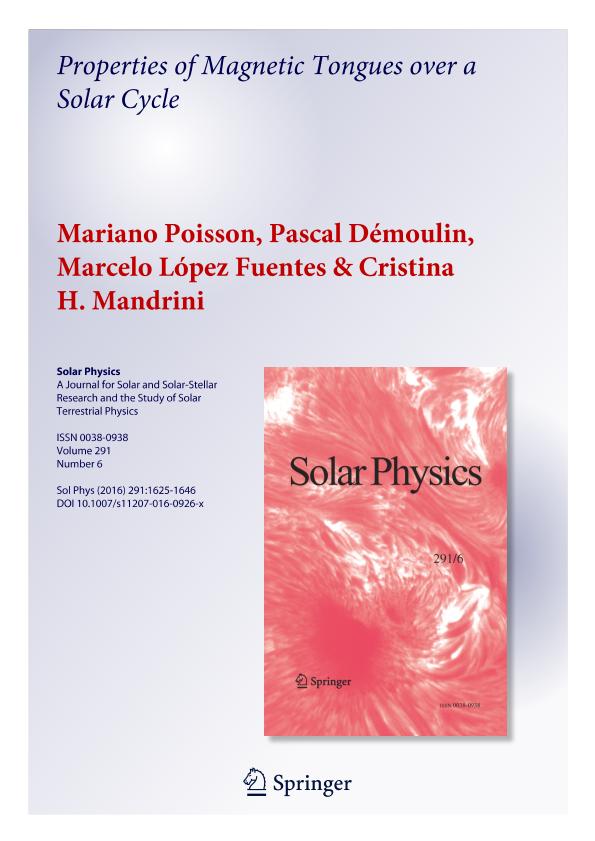Mostrar el registro sencillo del ítem
dc.contributor.author
Poisson, Mariano

dc.contributor.author
Démoulin, Pascal

dc.contributor.author
Lopez Fuentes, Marcelo Claudio

dc.contributor.author
Mandrini, Cristina Hemilse

dc.date.available
2017-07-28T19:50:30Z
dc.date.issued
2016-05
dc.identifier.citation
Poisson, Mariano; Démoulin, Pascal; Lopez Fuentes, Marcelo Claudio; Mandrini, Cristina Hemilse; Properties of Magnetic tongues over a Solar Cycle; Springer; Solar Physics; 291; 6; 5-2016; 1625-1646
dc.identifier.issn
0038-0938
dc.identifier.uri
http://hdl.handle.net/11336/21557
dc.description.abstract
The photospheric spatial distribution of the main magnetic polarities of bipolar
active regions (ARs) present during their emergence deformations are known as magnetic tongues. They are attributed to the presence of twist in the toroidal magnetic-flux tubes that form the ARs. The aim of this article is to study the twist of newly emerged ARs from the evolution of magnetic tongues observed in photospheric line-of-sight magnetograms. We apply the procedure described by Poisson et al. (Solar Phys. 290, 727, 2015a) to ARs observed over the full Solar Cycle 23 and the beginning of Cycle 24. Our results show that the hemispherical rule obtained using the tongues as a proxy of the twist has a weak sign dominance (53 % in the southern hemisphere and 58 % in the northern hemisphere). By defining the variation of the tongue angle, we characterize the strength of the magnetic tongues during different phases of the AR emergence. We find that there is a tendency of the tongues to be stronger during the beginning of the emergence and to become weaker as the AR reaches its maximum magnetic flux. We compare this evolution with the emergence of a toroidal flux-rope model with non-uniform twist. The variety of evolution of the tongues in the analyzed ARs can only be reproduced when using a broad range of twist profiles, in particular having a large variety of twist gradients in the direction vertical to the photosphere. Although the analytical model used is a special case, selected to minimize the complexity
of the problem, the results obtained set new observational constraints to theoretical models of flux-rope emergence that form bipolar ARs.
dc.format
application/pdf
dc.language.iso
eng
dc.publisher
Springer

dc.rights
info:eu-repo/semantics/openAccess
dc.rights.uri
https://creativecommons.org/licenses/by-nc-sa/2.5/ar/
dc.subject
Active Regions: Magnetic Fields
dc.subject
Corona: Structures
dc.subject
Helicity: Magnetic
dc.subject
Helicity: Observations
dc.subject
Helicity: Magnetic
dc.subject.classification
Astronomía

dc.subject.classification
Ciencias Físicas

dc.subject.classification
CIENCIAS NATURALES Y EXACTAS

dc.title
Properties of Magnetic tongues over a Solar Cycle
dc.type
info:eu-repo/semantics/article
dc.type
info:ar-repo/semantics/artículo
dc.type
info:eu-repo/semantics/publishedVersion
dc.date.updated
2017-07-27T12:49:52Z
dc.journal.volume
291
dc.journal.number
6
dc.journal.pagination
1625-1646
dc.journal.pais
Alemania

dc.journal.ciudad
Berlin
dc.description.fil
Fil: Poisson, Mariano. Consejo Nacional de Investigaciónes Científicas y Técnicas. Oficina de Coordinación Administrativa Ciudad Universitaria. Instituto de Astronomía y Física del Espacio. - Universidad de Buenos Aires. Facultad de Ciencias Exactas y Naturales. Instituto de Astronomía y Física del Espacio; Argentina
dc.description.fil
Fil: Démoulin, Pascal. Centre National de la Recherche Scientifique. Observatoire de Paris; Francia
dc.description.fil
Fil: Lopez Fuentes, Marcelo Claudio. Consejo Nacional de Investigaciónes Científicas y Técnicas. Oficina de Coordinación Administrativa Ciudad Universitaria. Instituto de Astronomía y Física del Espacio. - Universidad de Buenos Aires. Facultad de Ciencias Exactas y Naturales. Instituto de Astronomía y Física del Espacio; Argentina
dc.description.fil
Fil: Mandrini, Cristina Hemilse. Consejo Nacional de Investigaciónes Científicas y Técnicas. Oficina de Coordinación Administrativa Ciudad Universitaria. Instituto de Astronomía y Física del Espacio. - Universidad de Buenos Aires. Facultad de Ciencias Exactas y Naturales. Instituto de Astronomía y Física del Espacio; Argentina
dc.journal.title
Solar Physics

dc.relation.alternativeid
info:eu-repo/semantics/altIdentifier/doi/http://dx.doi.org/10.1007/s11207-016-0926-x
dc.relation.alternativeid
info:eu-repo/semantics/altIdentifier/url/https://link.springer.com/article/10.1007%2Fs11207-016-0926-x
Archivos asociados
